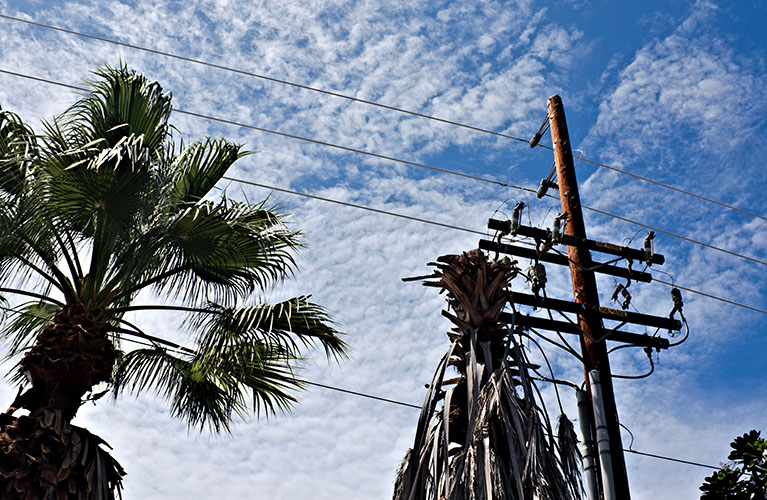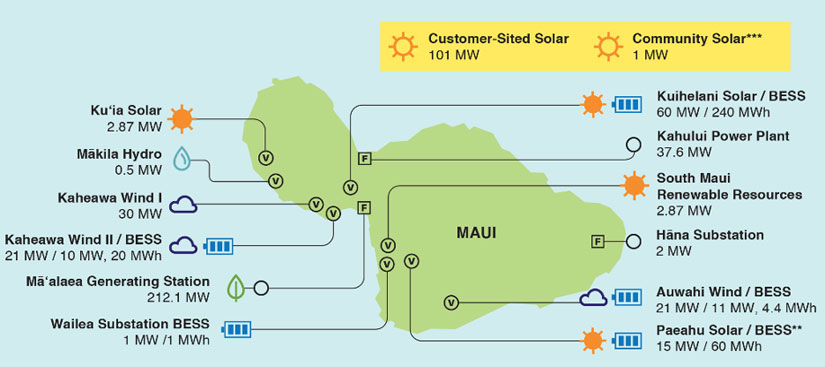NREL Methods Assist Maui in Approaching 100% Renewable Operations
New Capabilities Demonstrate How Renewables Can Stabilize and Support the Power Grid

Maui is not waiting until 2045 to meet Hawaii's clean energy mandates: The island is likely to become the first interconnected electric transmission system anywhere to operate with 100% wind and solar PV power on an instantaneous basis.
Through 2024, Maui is scheduled to bring online more than 175 MW of new solar-storage hybrid power plants. This, in addition to the almost 200 MW of wind and solar presently on the grid, will be enough renewable power to supply Maui's roughly 70,000 customers without using conventional generation for many hours of the year. But managing such a high proportion of resources that are inherently uncertain is a first for any grid of Maui's size, so the National Renewable Energy Laboratory (NREL) is developing and validating multi-timescale tools that will bring Maui and other systems closer to 100% clean and stable energy futures.
The MIDAS Touch for Maui Grid Operation: Managing Renewable Reliability and Scheduling
Wind and solar add a large share of uncertainty to the grid. At very high levels, they even alter the dominant physics and controls behind grid stability. Grid operators confront this uncertainty when scheduling wind and solar to provide power or grid stability services. Because renewable-dominant grids are so recent, there exist few systematic methods to schedule renewables for multi-timescale grid stability. As a result, most operators still treat renewable energy as non-dispatchable and uncontrollable when scheduling.
One thing is certain, however: Renewables alone can provide the services necessary to maintain the grid. Operators just need the tools to properly manage them.
"Technically, inverter-based resources like wind, solar, and battery storage can provide all types of grid ancillary services by programing the controls," explained Jin Tan, the principal investigator (PI) of several NREL projects aimed at enabling 100% renewable grid operations.
"The problem is that system operators largely do not use them. System operators need to incentivize renewables to provide grid services by developing new market rules. They need modern tools to validate the performance of renewable systems, or to manage risk—economic and operational—associated with scheduling variable resources like solar and wind," Tan said.

Tan has led the development of MIDAS, the Multi-Timescale Integrated Dynamic and Scheduling model, an NREL software that empowers grid operators to manage high-renewable systems, placing operational intelligence and advanced system analysis at their fingertips.
MIDAS, which is funded by the Department of Energy's Solar Energy Technologies Office (SETO), is a tool that could enrich existing operational tools for managing energy markets and conducting reliability analysis down to the fast time-scale dynamics. Unlike current tools, MIDAS bridges the gaps between the economic analysis and dynamic reliability evaluations of grid operation, so that grid operators can see the trade-offs of dispatching renewable (and nonrenewable) assets for a variety of grid services.
So far, MIDAS has enabled Maui to plan ahead for more renewables by modeling its operations under future low grid inertia. The Maui model can identify potential reliability issues before they happen, from resource adequacy (years to days) and energy balance (days to minutes) to frequency dynamics (minutes to seconds) and electromagnetic transient (sub-second) timescales, providing a uniquely complete picture of Maui's high-renewable system. For other systems reaching high-renewable, low-inertia levels, NREL's tools to assess multi-timescale reliability and stability could be critical.
"In the past, everything in power systems was exact. We could schedule and dispatch generation with the certainty of knowing that the system was stable," Tan said. "Now, with renewables, we need to consider new factors like the fast frequency response capability of inverter-based resources or the stability constraints of the grid. Otherwise, current scheduling models can no longer provide reliable results for day-to-day operation."
Snapshots of Stability: A Complete Electromagnetic Transient Model of Maui Island
At the sub-second scale, inverter-based resources (IBRs) such as wind and solar are beginning to make waves on low-inertia grids. While power systems have historically relied on spinning generators to smooth out sub-second disturbances, IBRs are displacing these generators, and Maui and related systems need a new supply of grid stability. NREL, a leading laboratory for low-inertia power systems, has some capabilities and ideas around how to help.
"No one has operated a power system the size of Maui's with 100% solar, wind, and batteries; to confidently operate any grid with 80–100% inverter-based resources on an instantaneous basis, there are important steps that we can take in the laboratory and on the field to prepare," said Andy Hoke, a senior research engineer at NREL. Hoke leads research on sub-second analysis, or electromagnetic transient (EMT) analysis, of high-renewable systems in order to validate their stability.
Being at the forefront of renewables, Maui merited an especially thorough EMT analysis in which Hoke and the NREL team modeled the entire island's transmission system—hundreds of lines, buses, and transformers; and solar, storage, and wind systems and their inverter controls—at a sub-second scale. Next, the NREL team simulated snapshots of Maui's future system: what it would like at low inertia, at no inertia, and with methods that restore inertia.
"We found that as Maui approaches 100% renewable operation, there are several options for ensuring grid stability," Hoke said. "Using synchronous condensers to stabilize, or even by programming grid-forming controls on a relatively small number of inverters, it is possible to stabilize a 100% renewable system on Maui, at least in simulation."
The team also found that conventional modeling tools can miss key stability dynamics in the case of extremely high IBRs. Moreover, even high-fidelity models might lack essential information, such as the proprietary controls of a commercial inverter. To be 100% sure of 100% stable renewable systems, NREL takes research a step closer to reality with at-scale hardware test beds.
A Final Proof Before the Field
Maui's final push toward full renewable operation is supported in part by SETO, which has doubled down on renewable system stability by awarding an NREL-led project titled "SAPPHIRE" to develop hybrid renewable power plant controls. The new $3.6 million project bridges research of Hoke and Tan by combining stabilizing controls with the MIDAS operational framework.
"This is an effort to address renewable operations from long-term planning down to EMT, such that Maui and other high-renewable systems have what they need to manage stable and economic systems," said Tan, who is PI on the SAPPHIRE project.
NREL will first use the Advanced Research on Integrated Energy Systems (ARIES) platform to develop and derisk the hybrid power plant controls at real power. ARIES provides a replica grid environment for Maui to validate its incoming medley of renewables and evaluate its real-time inertia and stability.
"To fully derisk 100% renewable systems, we need to run the hardware under real grid conditions," said Hoke, who is the co-PI and is developing dynamic stability controls for the project. "With ARIES, we can connect grid devices to real power and replicate the conditions they will experience in Maui. This is a sure way to confirm performance and stability before we take the controls live."
The project will conclude with a 60-MW demonstration on Maui's system, and, although the demonstration is only 3 years out, a proof of 100% renewables remains possible. If so, Maui would set a milestone for renewable energy and show that NREL technical capabilities and operational tools can achieve the same for clean energy systems anywhere.
Learn more about island power systems with high levels of renewables.
Last Updated May 28, 2025
